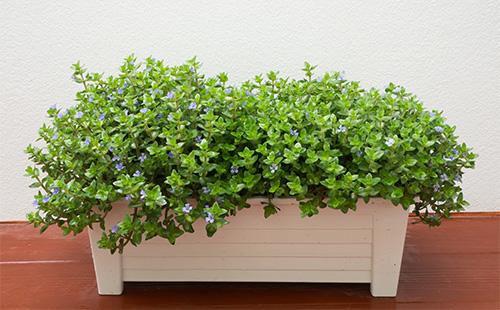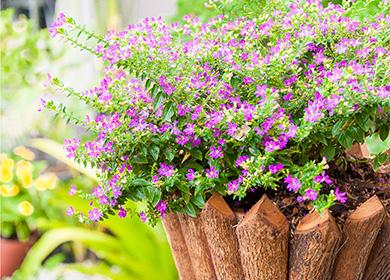The content of the article
Kafei belongs to the family of loosestrife. In Greek, the name of the plant sounds like a "curve." He was awarded for the unusual shape of the fruit. According to various sources, the genus consists of 200–250 species. Among them are herbaceous plants and shrubs.
Botanical Description
The coffees used in indoor floriculture are perennial shrubs up to half a meter high. The leaves are small, oval, rather dark, delicate. They are attached to the stem with short petioles. The kuffey bush has a beautiful fan shape.
The flowers are small, numerous, elongated. Many people compare the tubular shape of the flower and the unusual limb of the corolla to a smoldering cigarette, for which the plant was called the cigarette tree. The cafeteria blooms almost continuously from spring to autumn. There are types of coffees with fairly large, but not numerous buds. The color of the flower is white with a lemon tint, purple with a purple tint, pink, red.
Types of room culture
Of the whole variety of kufei, several are suitable for growing at home. The rest are cultivated as flower beds, or do not get along at all in our climate. The most common among flower growers are four varieties of coffees.
- Fiery red. Forms a small, neat bush up to half a meter high. During flowering, many tubular flowers bloom in bright red. Based on the species, several beautiful hybrid kufei varieties with different flowering periods, distinguished by the color of the flowers, were bred.
- Isopolistic. Compact bush, grows up to half a meter. It blooms from spring to mid-autumn. At the same time, many small flowers of lilac, pink or white bloom. This type of kufei can be grown outdoors.
- Pale. An interesting feature of the pale kafei is that the shoots grow in different directions, forming a very dense, dense, but compact bush. Flowers of a red wine tint, small. Flowering is plentiful and long. The plant looks good in hanging baskets.
- Micro-petal. A compact bush is not higher than 40 cm. The flowers are very small, formed just above the leaf sinuses. Calyx yellow, with a crimson base, green pharynx. Petals are small, hidden behind the teeth of the cup.
Cafe care, watering and transplant rules
How to care for a cafe? The plant is not capricious, grows fast, has a stable and lush flowering. For active growth and full flowering of coffees, it is enough to follow the basic requirements for the microclimate, simple rules of care.
- Lighting. Good lighting is needed to form flower buds. They keep the culture in bright diffused light, shade from the direct sun. The optimal location in the apartment is the western or eastern windows. In winter they rearrange it on the southern window - the cold winter sun does not harm the flower.
- Temperature. Koufey is a thermophilic plant. Optimum temperature in summer: 20-24 ° C. For repeated flowering the next year, a dormant period is forcedly created — wintering at 5–10 ° C. The culture does not withstand a further drop in temperature.
- Watering. In warm time, it is recommended to shed abundantly - at intervals of three to four days. Before watering, check the soil moisture level - the top layer should dry evenly. Full drying of an earthen coma is not allowed. The amount of water per irrigation depends on the volume of the pot - excess water must flow out through the drainage holes. Half an hour after watering, the accumulated water from the pan is drained. In hot weather, the coffee is watered more often - the flower reacts to drought by dropping buds.
- Humidity. Loves high humidity. Spraying is required at least three times a week. Additional measures to increase humidity are usually not required. But in winter, you can hang the batteries with a damp cloth.
- Top dressing. You can feed the caffeine already when planting. In the pot, directly at the roots, put a little well-rotted humus. With the advent of the first buds, mineral fertilizers are introduced for flowering crops. Then they continue to feed every two weeks with drugs with a high content of potassium and phosphorus.
- The soil. Any slightly acid shop soil is suitable. The basic requirements for the substrate are nutritious, loose, light. At home, a soil mixture is prepared from garden soil, humus or peat, perlite or sand. All components are mixed in approximately equal amounts.
- Transfer. It is better to transplant the coffer by the method of transshipment - do not injure the root system. Young plants need a transplant annually, adults less often - after two years. A new pot is taken a little larger in diameter - about 2-3 cm.
- Pruning. Periodically, you need to trim the dried leaves from the coffees, remove withered flowers, dry shoots. Each variety has its own pruning features. The leafy caffeine is pruned heavily - at the end of winter, all branches are half cut to stimulate the growth of young shoots, flower buds. In fiery red kuffeys, simply stretched, incorrectly growing branches are simply cut to give the bush a beautiful shape.
Breeding technique
Most often, flower growers practice propagation of kufei by cuttings. Plants of a new variety are easily grown from seeds. Get healthy plants is not difficult - just follow the recommendations of experienced breeders.
Seeds
Growing kafei from seeds at home always gives good results. Seeds are quite large, curved, highly germinated. Seedlings are growing fast. Sown them in early spring according to the following scheme of four actions.
- A transparent container with a lid is filled with nutritious soil mixture. You can use peat with sand or any loose, breathable soil.
- Seeds are laid out on the surface of the substrate, slightly pressed into it. Do not deepen deeply - for germination you need light.
- The substrate is sprayed from the spray bottle with warm water. Cover the container. They put in a warm, bright place.The temperature should not fall below 20 ° C.
- Shoots appear in a week. At the stage of two or three true leaves, they need to be planted in separate containers. Seedlings grow quickly - choose a pot with a diameter of at least 11 cm. As the seedlings grow, a second transplant is required.
Cuttings
The best time for grafting is spring. The apical cuttings are taken from young, not lignified shoots. Cut at an angle with a sharp sterile knife. Then we adhere to the following scheme of four actions.
- Warm water is poured into a glass, any root formation stimulant is added to it - “Kornevin”, “Heteroauxin”. To prevent decay, a tablet of activated carbon is thrown into the water.
- Cuttings are placed in water, kept in a warm, bright place. The roots appear very quickly - in a week. They don’t immediately land them - they wait for them to become larger.
- Rooted cuttings are transplanted into the ground. In one pot, you can plant several shoots at once to obtain a lush bush. The first time watered sparingly, do not allow the temperature to drop.
- After the appearance of several new leaves, the coffees begin to form - pinch the tops to stimulate lateral branching.

Growing problems
Difficulties in growing coffees are rare. But sometimes non-compliance with the conditions of detention leads to a decrease in decorativeness. For your convenience, the table contains the main difficulties that gardeners have to deal with.
Table - Problems in growing kufey
| Problem | What is the reason | Necessary measures |
|---|---|---|
| The appearance of dark spots on the leaves | - Lack of light in winter; - decay of the root system | - The use of artificial lighting with a lack of natural light; - inspection of the root system; - removal of rotten areas; - transplant |
| Leaf fall | - Sharp temperature changes; - prolonged heat or cold | - Normalization of the conditions for the coffees; - maintaining the optimum temperature for the plant |
| Yellowing leaves | - Excess of light; - the appearance of pests; - drying of soil | - Inspection of the plant for the presence or absence of pests; - shading from the summer sun; - regular, plentiful watering |
| Falling leaves | - Lack of nutrition; - too close a pot | - Plant transplant with soil replacement; - application of mineral fertilizers |
| Bud drop | - Drying of the soil; - frequent drafts; - sharp temperature changes | - Watering as the surface of the substrate dries; - content in a warm, draft-free place |
Common diseases
The cafeteria is quite resistant to diseases. Sometimes, with unregulated watering, it is affected by fungal diseases, rot. A description of the main diseases of kuffey and their treatment can be found in the table.
Table - Kuffey Diseases
| Disease | Signs | Treatment |
|---|---|---|
| Chlorosis (iron deficiency) | - The appearance of spots; - yellowing of leaves when only veins remain green | - Spraying with preparations with iron chelate |
| Gray rot (fungus) | - Decay of the root neck; - formation on the leaves of a gray fluffy coating | - Trimming the affected parts of the coffey; - treatment with the drug "Fitosporin"; - transplantation into a new sterile soil |
| Powdery mildew (fungus) | - The appearance on the leaves of a whitish powdery coating; - yellowing, withering or drying of the coffey | - Stop spraying; - carrying out strong trimming; - spraying with any systemic fungicide |
Typical pests
You have to deal with pests more often. Tender leaves of kafei are often affected by aphids, whiteflyspider mite. Detailed information on pests, signs of their appearance and methods of control can be found in the table.
Table - Kofey Pests
| Insect | Signs | Necessary measures |
|---|---|---|
| Whitefly | - The appearance on the plant of small flying insects of white color; - detection of a colony of larvae on the back of the leaves; - withering kufei, stunting | - Processing of kufei with Actellik, Inta-Vir preparations, until the complete disappearance of insects; - preventive treatments with the same means |
| Spider mite | - The appearance of small yellowish dots on the leaves; - Detection of thin cobwebs on the leaves of kufei; - yellowing and falling of leaves | - Rinsing the cofeee with a solution of potassium soap; - spraying the plant with the drug "Actara"; - increase air humidity by any means |
| Shield | - Detection of insect leaves with a convex brown carapace; - Coating kafei leaves with a sticky coating; - the appearance of soot fungus | - Removing shields from plants mechanically; - wiping the places of accumulation of insects with alcohol, washing with soapy water; - spraying with Inta-vir |
| Thrips | - Deformation of kufei leaves, silver coating; - shedding pollen from flowers; - detection of black dots on leaves, holes on flowers | - Bathing coffees under a warm shower; - spraying with an insecticide for flowers |
| Nematodes | - Damage to the root system of kufei; —Deformation, curl of leaves, stains | - Destruction of an infected plant |
| Aphid | - Twisting the tops of the young sprouts of kafei; - detection of sticky, sugar coating on the leaves; - stopping the bush in growth, wilting of the plant | - Bathing a flower in the shower using a soap solution; - spraying leaves with tobacco dust infusion or with a preparation containing permethrin |
Caring for a cafeteria in a pot is a simple and interesting task. Its main advantage is long and plentiful flowering. Unpretentiousness and high decorativeness make it an excellent decoration of any interior.

